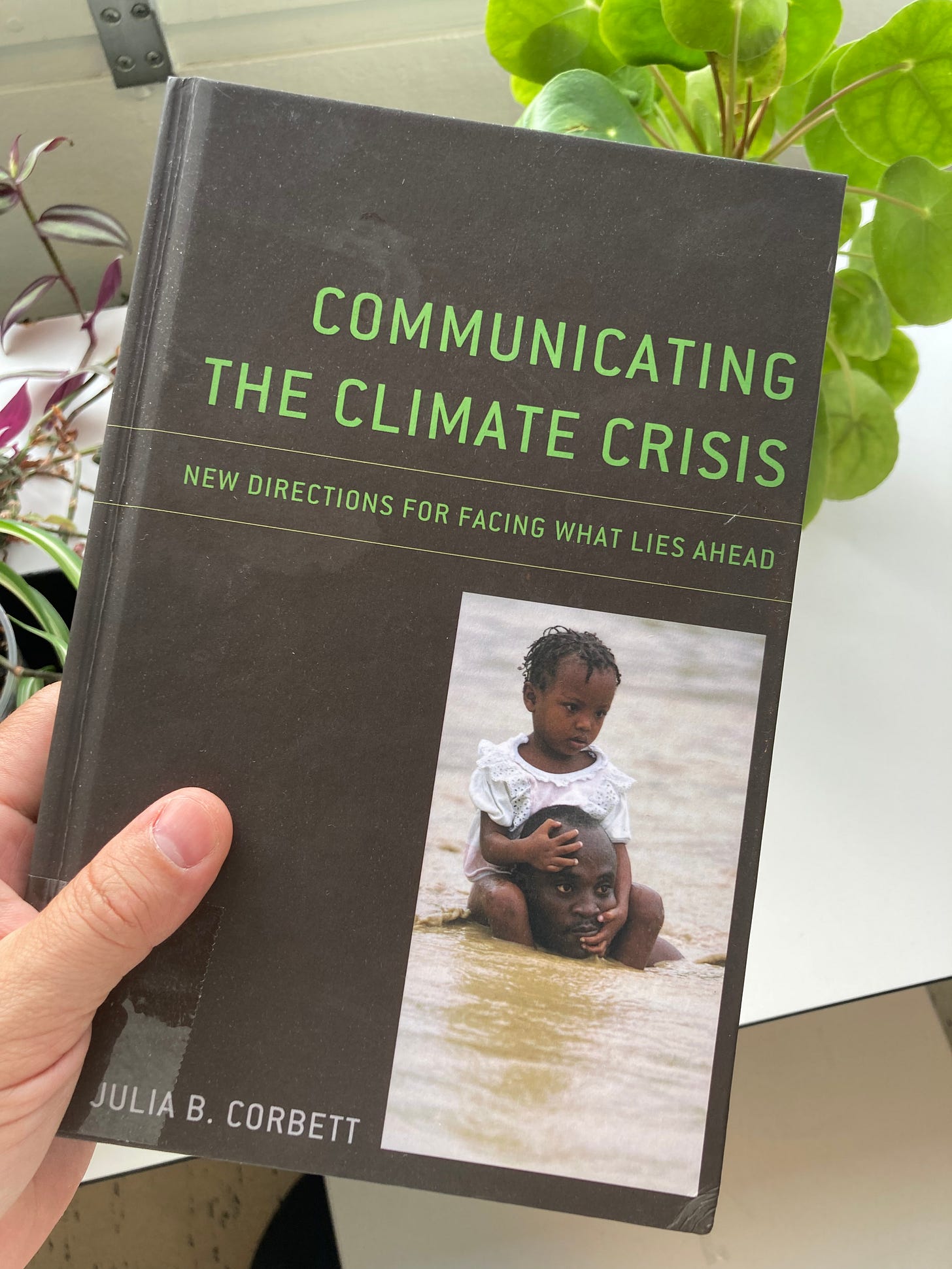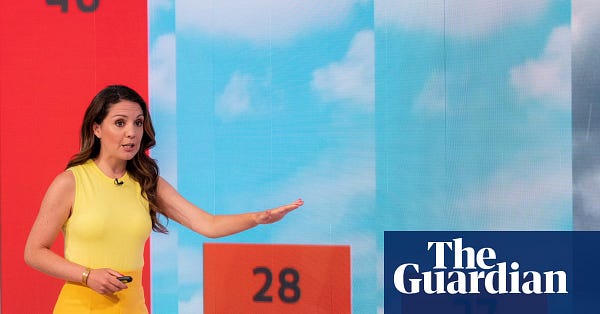🌿Wild Ones #64: Environmental Communication Digest
Environmental keyword: Eairth + James Lovelock: From Gaia to Cyborgs + Reclaiming Aloha + ecolinguistic perspectives on the Anthropocene + more!

Hi everyone, welcome back to Wild Ones, a (usually) weekly digest by me, Gavin Lamb, about news, ideas, research, and tips in environmental communication. If you’re new, welcome! You can read more about why I started Wild Ones here. Sign up here to get these digests in your inbox:
🌱Environmental Keyword
Eairth
“Perhaps we should add the letter i to our planet's name, and call it "Eairth," in order to remind ourselves that the "air" is entirely a part of the eairth, and the i, the I or self, is wholly immersed in that fluid element.”
– David Abram, in Becoming Animal, p. 101.
I’ve been reading – in bits and pieces – a new book published this year by Julia Corbett, Emerita Professor in the Department of Communication and Environmental Humanities at the University of Utah. The book is called: Communicating the Climate Crisis: New Directions for Facing What Lies Ahead. An environmental keyword Corbett uses throughout the book is Eairth, with a spelling that made me pause for a second, and try to figure out how to pronounce it (Eeaayrth?). Corbett develops the keyword from the work of David Abram in sensory anthropology and environmental philosophy:
“Philosopher David Abram suggested we add an i to our planet’s name Earth (and yes, it sounds Scottish when he says it) - to remind us that we live in this “amniotic substance” and not merely on the surface:
The air is not a random bunch of gases simply drawn to earth by the earth’s gravity, but an elixir generated by the soils, the oceans, and the numberless organisms that inhabit this world, each creature exchanging certain ingredients for others as it inhales and exhales, drinking the sunlight with our leaves or filtering the water with our gills, all of us contributing to the composition of this phantasmagoric brew. It is as endemic to the earth as the sandstone beneath my boots. What we call “air” is a product made and moved by all of us - ants, humans, trees, bacteria, plankton, zebras - all interacting within the amniotic atmosphere.”
– David Abram, cited by Julia Corbett in Communicating the Climate Crisis.
In proposing the term ‘Eairth,’ Abram seeks to work on our perceptions just enough to make us re-experience the air again, not as empty space, but as something tangible and alive that we are immersed in. Looking out my office window now at trees wiggling in the wind, the word Eairth does seem to stir up reminders for me that I’m not just existing on the earth, but rather, immersed in an eairthy “phantasmagoric brew”😊
Corbett’s book takes the reader through a series of arguments about how to understand the role of climate communication in transforming the “individualistic consumer identity fostered by fossil fuel culture.” Instead, our communication strategies should inspire in us a sense of being agentive ‘social actors’ equipped with “alternative narratives that disrupt existing practices and beliefs and challenge the current social order.”
There’s a lot of helpful communication strategies in the book, especially for navigating emotional and moral framings of environmental issues in everyday conversations. In particular, the book’s message for climate communicators is a call to confront the individualizing consumer discourse of ‘fossil fuel culture’ by creating new stories that expand our sense, not as atomized individuals, but as social actors sitting at the nexus of a web of influence. This idea resonates with another new book I recommend checking out called “You Matter More Than You Think: Quantum Social Change for a Thriving World,” (2021), by Karen O’Brien, Professor of Human Geography at the University of Oslo in Norway. For those looking to infuse their environmental communication with action-oriented hope (in the style of climate scientist Katharine Hayhoe) I recommend reading these two books together:)

📚 What I’m reading
Our Cyborg Progeny: a review of ‘Novacene: The Coming Age of Hyperintelligence’ by James Lovelock (2020). By Meehan Crist in the London Review of Books. James Lovelock, who proposed and co-developed the ‘Gaia Hypothesis’ with Lynn Margulis, recently passed away on July 26, so I’m returning to this fascinating essay by Meehan Crist that reviews Lovelock’s Gaia hypothesis, as well as his most recent book: Novacene. The essay is an excellent piece of environmental writing, and gave me insight into some of Lovelock’s evolving, fascinating, and at times, problematic environmental ideas. Here’s a snippet from an old Wild Ones edition I wrote a couple of years ago when I first read Meehan’s piece about Lovelock:
Lovelock’s new book Novacene continues to develop the Gaia hypothesis in rather strange directions. Or as Crist puts it, “this book is a bit nuts.” But Crist doesn’t just critique Lovelock’s book. Instead, she places the particular climate story Lovelock tells within a rich history of earth science and the “sometimes vitriolic culture war…waged along the continuum between hope and despair.”
Unraveling, by Terry Tempest Williams. In this essay Williams “searches for what is revealed when worlds unravel, tracing the entangled nature of undoing and becoming.” In Emergence Magazine.
Environmental Action Newsletter Archive (1970 - 1983). From the University of Pittsburgh Digital Collection.
Ecology and Social Justice: Is there a conflict? In the August 5, 1972 issue of Environmental Action: “With a socio-economic system which blesses the rich with profits and the poor with pollution, we should not be surprised at minority and poor communities’ skepticism of our Earth Day-type admonitions to all link arms and fight pollution.”

🎧 What I’m listening to
Reclaiming Aloha. An interview with Dr. Jamaica Heolimeleikalani Osario on the For The Wild podcast. “In the same way that Aloha asks us to recognize each other, it also asks us to recognize our relationship to the ʻĀina, to the land, to that which feeds us, that which is around us.”
🔍 Tools & Resources
UCLA’s Critical Media Literacy Library: Climate Change and Environmental Justice. A fantastic collection of publications, film, podcasts, blogs, reports and more. Check out this video on ‘Ecomedia’ created by Aaron Kierbel from their Critical Media library:
PhD position: Environmental communication in Global South contexts. Swedish University of Agricultural Sciences
📰 News and Events


Free Course🎓: How to cover the climate crisis – and fight disinformation August 8 to September 4. Instructor: John Schwartz. Knight Center, University of Texas at Austin.
Interview🎙️: Q&A: Inside Climate News’s Marianne Lavelle on the long road to climate action. By Covering Climate Now, in the Columbia Journalism Review: “Too often, the reporters who cover politics are seemingly not able to pose the follow up questions that are necessary…we have to be challenging the crazy things politicians say about climate and the environment.”
📚 Research
Environmental issues in the Anthropocene: ecolinguistic perspectives across media and genres. By Douglas Mark Ponton and Małgorzata Sokół (eds). Special issue in Text and Talk (2022). Some of the articles in the issue include:
“This special issue takes up the discussion of environmental issues against the background of the Anthropocene – the Age of Humankind, “a proposed geological epoch aimed at indicating the transformative impact of human beings on the planet’s ecosystem”…our aims are twofold: 1) to contribute to the exploration of the term from linguistic and discursive perspectives; and 2) to address environmental issues across the diversity of media and genres in the context of the effects of human practices and their potential.”
Re-MEDIAting distant impacts - how Western media make sense of deforestation in different Brazilian biomes. Finn Mempel and Francisco Bidone in Environmental Sociology.


Editorial: Helping scientists to communicate well for all considered: Strategic science communication in an age of environmental and health crises. By Brianne Suldovsky, Marcia Allison, Marina Joubert, Ingrid E. Lofgren and Scott McWilliams. In Frontiers in Communication. (August 3, 2022).
💡 Ideas
Banned Books Every Climate Nerd Should Read. By Angely Mercado in Earther. Some of the books include:
The Lorax by Dr. Seuss; Native Son by Richard Wright; John Steinbeck’s The Grapes of Wrath; Upton Sinclair’s The Jungle; An Indigenous Peoples’ History of the United States for Young People by Roxanne Dunbar-Ortiz…


How a 50-year-old PR strategy influenced the Supreme Court’s EPA decision. “E. Bruce Harrison developed the "Three Es" [Environment, Energy, and Economy] in the 1970s. Now the framing is everywhere.” By Kate Yoder in Grist.
James Lovelock: the scientist-inventor who transformed our view of life on Earth. By Mark Maslin, in The Conversation:
“James Lovelock, the maverick scientist and inventor, died surrounded by his family on July 27 2022 – his 103rd birthday. Jim led an extraordinary life. He is best known for his Gaia hypothesis, developed with the brilliant US biologist Lynn Margulis in the 1970s, which transformed the way we think of life on Earth….Lovelock also inspired the environmental movement by giving his ideas a spiritual overtone: Gaia was the goddess who personified the Earth in Greek mythology. This antagonised many scientists, but created a lot of fruitful debate in the 1980s and 1990s.”


💬 Quote I’m thinking about
“We can reweave the world anew, not from the places of fear and doubt, but from the intimate spaces of belonging we must retrieve for ourselves. We are Earth unraveling and reforming creation. We are meant to engage not isolate. These are difficult days. What causes us to recoil, strike, and retreat is also what allows us to reach out from the anxiety of unknowing and dare to trust what is to come—a reassembling of our humanity. There is something deeper than hope. Between the hours of darkness and dawn, the voices of our ancestors are amplified in the dreamtime—warning us of our awakening wisdom—a blessing to behold and a burden to enact.”
– from Unraveling, an essay by Terry Tempest Williams, in Emergence Magazine (May 2022).
Thanks so much as always for your interest in my work, and if you found this digest useful, please consider sharing with others who might find it interesting too😊 I'd also love to hear from you. Leave a comment to let me know what you think about this digest, what areas of environmental communication you’re involved in/most interest you, or anything you’d like to see more of in Wild Ones:)

